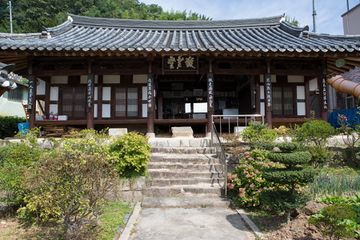"진주 경로당"의 두 판 사이의 차이
(→영문) |
(→영문) |
||
| 30번째 줄: | 30번째 줄: | ||
'''Jinju Hall for the Elderly''' | '''Jinju Hall for the Elderly''' | ||
| − | This traditional Korean house was | + | This traditional Korean house was built in 1934. It was the first facility built for the elderly in the Jinju area. |
The hall consists of a main quarters and gate quarters. The wooden plaque hung on the main quarters bears the name of this building, “Gyeongnodang (敬老堂),” meaning “a hall where the elderly are respected.” The plaque was calligraphed by Ha Dong-ju (1879-1944), a famous calligrapher of the Jinju area. | The hall consists of a main quarters and gate quarters. The wooden plaque hung on the main quarters bears the name of this building, “Gyeongnodang (敬老堂),” meaning “a hall where the elderly are respected.” The plaque was calligraphed by Ha Dong-ju (1879-1944), a famous calligrapher of the Jinju area. | ||
2019년 8월 20일 (화) 19:13 판
| 진주 옥봉 경로당 |
|
 "진주 경로당", 국가문화유산포털, 문화재청. |
|
| 대표명칭 | 진주 옥봉 경로당 |
|---|---|
| 한자 | 晋州 玉峰 敬老堂 |
| 주소 | 경상남도 진주시 옥봉동 477-2 |
| 지정번호 | 문화재자료 제359호 |
| 지정일 | 2004년 10월 21일 |
| 분류 | 유적건조물/주거생활/주거건축/주거시설 |
| 시대 | 일제강점기 |
| 수량/면적 | 2동 |
| 웹사이트 | "진주 경로당", 국가문화유산포털, 문화재청. |
|
|
|
해설문
국문
진주 경로당은 1934년에 지어진 한옥으로 최초의 경로당 건물이라는 데 그 의의가 있다. 경로당은 본채와 대문채를 갖추고 있다. 경로당 현판에는 진주에서 추사체의 맥을 이어 활동하던 서예가 성파 하동주의 글씨가 적혀 있다.
경로당 옆에는 보로당(保老堂) 고개가 있는데, 이 고개의 이름은 경로당 때문에 생겨난 것으로 추정된다.
영문
Jinju Hall for the Elderly
This traditional Korean house was built in 1934. It was the first facility built for the elderly in the Jinju area.
The hall consists of a main quarters and gate quarters. The wooden plaque hung on the main quarters bears the name of this building, “Gyeongnodang (敬老堂),” meaning “a hall where the elderly are respected.” The plaque was calligraphed by Ha Dong-ju (1879-1944), a famous calligrapher of the Jinju area.
영문 해설 내용
진주 경로당은 일제강점기인 1934년에 지어진 한옥이다. 진주시 최초의 양로시설이다.
경로당은 본채와 대문채를 갖추고 있다. 본채 전면에 걸려있는 현판에는 ‘경로당(敬老堂)’ 즉 ‘노인을 공경하는 곳’이라고 쓰여 있다. 현판의 글씨는 진주의 대표적인 서예가인 하동주(1879-1944)가 쓴 것이다.